
Vinyl’s big selling point, some argue, is that it’s analog from recording to release. There’s no digital anything defiling those virgin musical notes; no digital microphones, no DACs, no computers, only analog sound waves etched directly into lacquer. That’s almost never the case because most vinyl records are made with a digital master; masters, for reference, are the original, final, highest-quality version of the song used to make copies for other mediums.
It may seem like this is a new thing that only emerged prior to CDs in the 1980s, but that’s sadly not the case. Digital recording goes way back to 1976 — for reference, the Rolling Stones were touring Europe that year. There is a very good chance that any record pressed after that date originates from a digital master. Digital audio eventually replaced every other aspect of the recording process, too, meaning vinyl might be the only truly analog link in the chain. Especially nowadays with modern artists (who record and produce entirely in digital) doing their own limited-edition vinyl runs.
This doesn’t mean it’s impossible to procure an untainted analog vinyl record, or its original analog master. In some rare cases, analog tapes exist of a song recorded in the pre-digital age. Also, a small minority of modern musicians choose to make some (or all) of their recordings on analog tapes, too. Even then, there’s still a strong chance digital was used at some point in the pipeline before a song was cut to lacquer — such as mastering it in a DAW — which arguably sullies that analog purity.

